HA2032 Corporate & Financial Accounting: Consolidation After Takeover
VerifiedAdded on 2023/04/03
|18
|3654
|157
Report
AI Summary
This report provides an overview of consolidation accounting principles in the context of business combinations, focusing on the effects of corporate takeovers. It begins by defining key terms such as business combination, acquisition date, acquirer, and acquiree, and differentiating between consolidation and equity accounting. The report details the process of consolidation accounting, including the identification of the acquirer and acquisition date, the recognition and measurement of acquired assets and liabilities, and goodwill valuation. It also explores intragroup transactions, emphasizing the elimination of unrealized profits and intragroup receivables and payables, and examines the treatment and measurement of non-controlling interests (NCI), including the effects of NCI disclosure on annual reports. The study references AASB standards, providing a comprehensive understanding of the regulatory requirements for consolidated financial statements.

HOLMES INSTITUTE
STUDENT NAME
STUDENT NO
ASSIGNMENT
1
STUDENT NAME
STUDENT NO
ASSIGNMENT
1
Paraphrase This Document
Need a fresh take? Get an instant paraphrase of this document with our AI Paraphraser
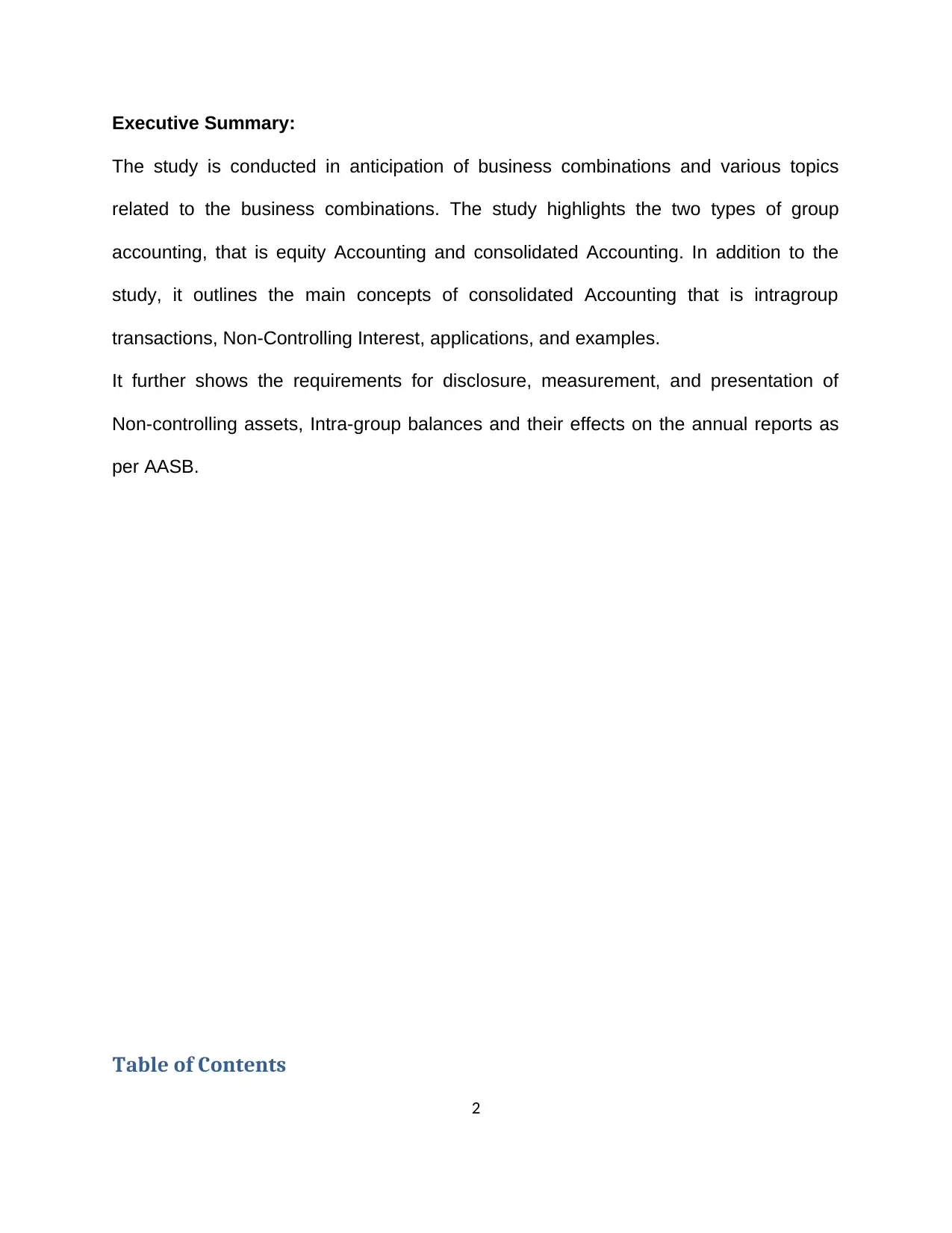
Executive Summary:
The study is conducted in anticipation of business combinations and various topics
related to the business combinations. The study highlights the two types of group
accounting, that is equity Accounting and consolidated Accounting. In addition to the
study, it outlines the main concepts of consolidated Accounting that is intragroup
transactions, Non-Controlling Interest, applications, and examples.
It further shows the requirements for disclosure, measurement, and presentation of
Non-controlling assets, Intra-group balances and their effects on the annual reports as
per AASB.
Table of Contents
2
The study is conducted in anticipation of business combinations and various topics
related to the business combinations. The study highlights the two types of group
accounting, that is equity Accounting and consolidated Accounting. In addition to the
study, it outlines the main concepts of consolidated Accounting that is intragroup
transactions, Non-Controlling Interest, applications, and examples.
It further shows the requirements for disclosure, measurement, and presentation of
Non-controlling assets, Intra-group balances and their effects on the annual reports as
per AASB.
Table of Contents
2

Introduction.................................................................................................................................................4
Key definitions:........................................................................................................................................4
A. Consolidation Accounting and Equity Accounting:..................................................................................5
Process of Methods of Consolidation Accounting...................................................................................5
Equity Accounting:...................................................................................................................................8
Differences between consolidated Accounting and Equity Accounting.................................................10
B. Intragroup Transactions:.......................................................................................................................10
Receivable and Payables........................................................................................................................12
C. Non-Controlling Interest........................................................................................................................13
Treatment of Non controlling Interest..................................................................................................14
Measurement of Non-Controlling Interest............................................................................................15
Effects of NCI disclosure to the Annual Report......................................................................................15
Conclusion:................................................................................................................................................16
References.................................................................................................................................................17
Introduction
3
Key definitions:........................................................................................................................................4
A. Consolidation Accounting and Equity Accounting:..................................................................................5
Process of Methods of Consolidation Accounting...................................................................................5
Equity Accounting:...................................................................................................................................8
Differences between consolidated Accounting and Equity Accounting.................................................10
B. Intragroup Transactions:.......................................................................................................................10
Receivable and Payables........................................................................................................................12
C. Non-Controlling Interest........................................................................................................................13
Treatment of Non controlling Interest..................................................................................................14
Measurement of Non-Controlling Interest............................................................................................15
Effects of NCI disclosure to the Annual Report......................................................................................15
Conclusion:................................................................................................................................................16
References.................................................................................................................................................17
Introduction
3
⊘ This is a preview!⊘
Do you want full access?
Subscribe today to unlock all pages.

Trusted by 1+ million students worldwide
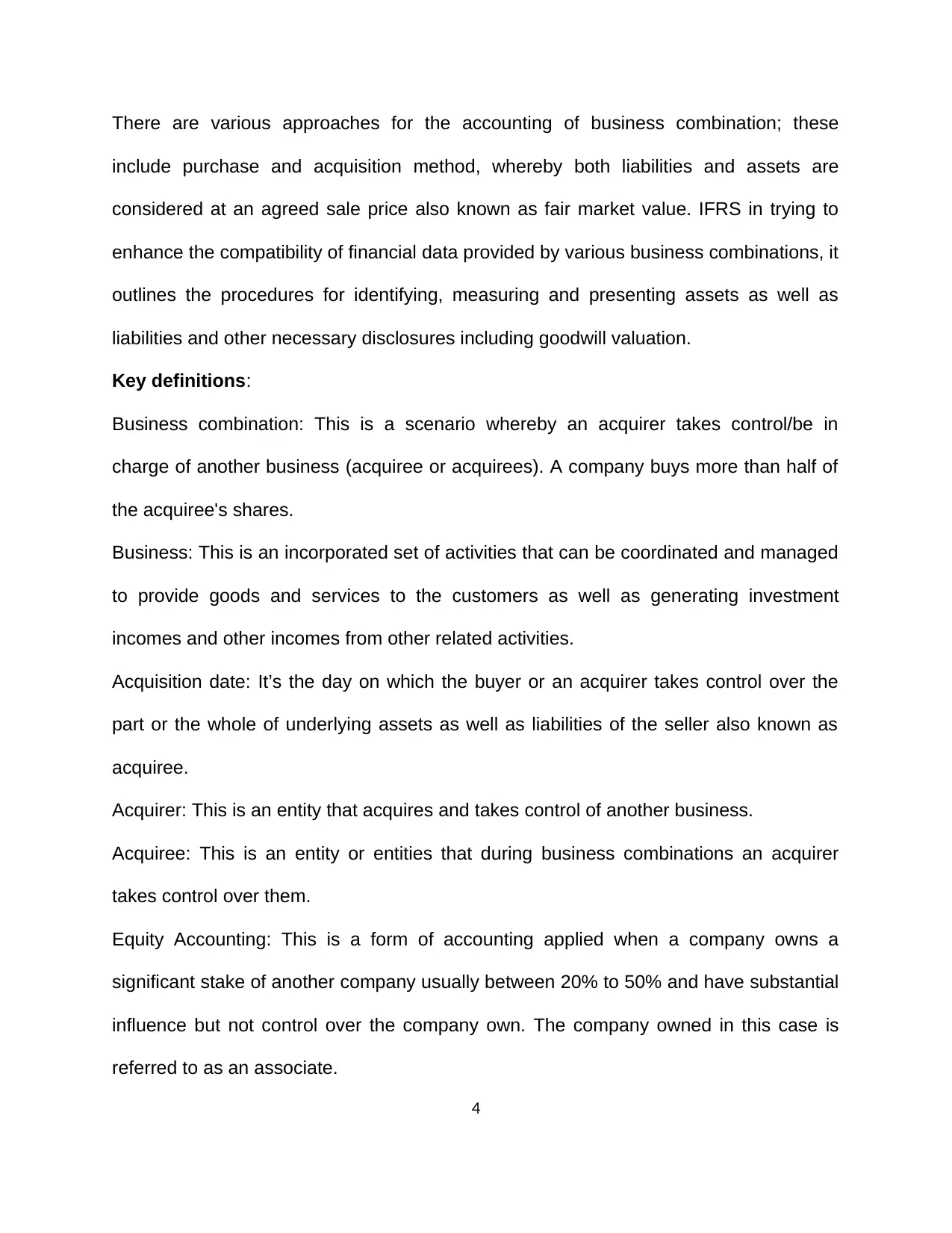
There are various approaches for the accounting of business combination; these
include purchase and acquisition method, whereby both liabilities and assets are
considered at an agreed sale price also known as fair market value. IFRS in trying to
enhance the compatibility of financial data provided by various business combinations, it
outlines the procedures for identifying, measuring and presenting assets as well as
liabilities and other necessary disclosures including goodwill valuation.
Key definitions:
Business combination: This is a scenario whereby an acquirer takes control/be in
charge of another business (acquiree or acquirees). A company buys more than half of
the acquiree's shares.
Business: This is an incorporated set of activities that can be coordinated and managed
to provide goods and services to the customers as well as generating investment
incomes and other incomes from other related activities.
Acquisition date: It’s the day on which the buyer or an acquirer takes control over the
part or the whole of underlying assets as well as liabilities of the seller also known as
acquiree.
Acquirer: This is an entity that acquires and takes control of another business.
Acquiree: This is an entity or entities that during business combinations an acquirer
takes control over them.
Equity Accounting: This is a form of accounting applied when a company owns a
significant stake of another company usually between 20% to 50% and have substantial
influence but not control over the company own. The company owned in this case is
referred to as an associate.
4
include purchase and acquisition method, whereby both liabilities and assets are
considered at an agreed sale price also known as fair market value. IFRS in trying to
enhance the compatibility of financial data provided by various business combinations, it
outlines the procedures for identifying, measuring and presenting assets as well as
liabilities and other necessary disclosures including goodwill valuation.
Key definitions:
Business combination: This is a scenario whereby an acquirer takes control/be in
charge of another business (acquiree or acquirees). A company buys more than half of
the acquiree's shares.
Business: This is an incorporated set of activities that can be coordinated and managed
to provide goods and services to the customers as well as generating investment
incomes and other incomes from other related activities.
Acquisition date: It’s the day on which the buyer or an acquirer takes control over the
part or the whole of underlying assets as well as liabilities of the seller also known as
acquiree.
Acquirer: This is an entity that acquires and takes control of another business.
Acquiree: This is an entity or entities that during business combinations an acquirer
takes control over them.
Equity Accounting: This is a form of accounting applied when a company owns a
significant stake of another company usually between 20% to 50% and have substantial
influence but not control over the company own. The company owned in this case is
referred to as an associate.
4
Paraphrase This Document
Need a fresh take? Get an instant paraphrase of this document with our AI Paraphraser

A. Consolidation Accounting and Equity Accounting:
Consolidated Accounting is done for group companies where the reporting entity is
supposed to present its’ financial statements showing the portion of the subordinate
company assets and liabilities under its control, (Kouseran and Saba, 2011). IFRS 3
provides the qualification of a transaction to meet being a combination business and so
consolidated Accounting applied.
Consolidated Accounting can be applied in business combinations structured in different
ways, for instance; where the parent company has transferred cash or any other asset
to the subsidiary company or has incurred liability on behalf of the acquiree or issuance
of equity instruments eg shares.
Process of Methods of Consolidation Accounting
Identification of acquirer- Acquirer refers to an entity that has transferred the cash or
other economic resources to the acquiree and has control over the interests and
decision of the acquired business. The acquirer can be identified in terms of revenue,
asset and profit size which are relatively bigger than that of the subsidiary and has
acquired more than 50% of the subsidiary assets. In some cases, business
combinations involve multiple combinations, the entity that initiates transaction is
considered and the level the relative sizes of entities making combination evaluated and
also consideration done
Identification of acquisition date: Acquirer determines the day when it obtained control
over the subsidiary. It is the day before or later than the reporting/closing date.
However, the IFRS III doesn’t give the complete guidelines on how to evaluate the
5
Consolidated Accounting is done for group companies where the reporting entity is
supposed to present its’ financial statements showing the portion of the subordinate
company assets and liabilities under its control, (Kouseran and Saba, 2011). IFRS 3
provides the qualification of a transaction to meet being a combination business and so
consolidated Accounting applied.
Consolidated Accounting can be applied in business combinations structured in different
ways, for instance; where the parent company has transferred cash or any other asset
to the subsidiary company or has incurred liability on behalf of the acquiree or issuance
of equity instruments eg shares.
Process of Methods of Consolidation Accounting
Identification of acquirer- Acquirer refers to an entity that has transferred the cash or
other economic resources to the acquiree and has control over the interests and
decision of the acquired business. The acquirer can be identified in terms of revenue,
asset and profit size which are relatively bigger than that of the subsidiary and has
acquired more than 50% of the subsidiary assets. In some cases, business
combinations involve multiple combinations, the entity that initiates transaction is
considered and the level the relative sizes of entities making combination evaluated and
also consideration done
Identification of acquisition date: Acquirer determines the day when it obtained control
over the subsidiary. It is the day before or later than the reporting/closing date.
However, the IFRS III doesn’t give the complete guidelines on how to evaluate the
5

acquisition date, but the identified date should show all relevant circumstances and
facts.
Identification of acquired assets and liabilities: The below guidelines are provided by
IFRS 3 relating to identification and presentation of items that arise from business
combinations.
Recognition Principle: According to this principle, the controlled assets by Acquirer,
proposed liabilities and the non-controlling interest in the subsidiary’s assets are
identified and reported separately from goodwill.
Measurement Principle: It states that all underlying assets purchased should be
valued at the fair value on the acquisition date (Jackson and Chapman, 2012)
The following are exceptions of recognition and measurement principles.
a) In reference to IAS 17, contingent assets and liabilities don't apply to contingent
liabilities resulting from the business combination.
b) Income tax is acknowledged and valued in line with IAS 12.
c) Assets and Liabilities arising from employees benefits arrangements of the subsidiary
are not valued and recognized as per the above to principle but based on IAS 19
employees’ benefits.
d) Indemnified assets are acknowledged by the parent company on the same day and
on the basis of recognizing other assets.
e) The reacquired asset is measured on the basis of the remaining agreed term without
a renewal.
f) In the case of share-based Payment transactions, they are valued in line with IFRS 2
of Share-based Payments.
6
facts.
Identification of acquired assets and liabilities: The below guidelines are provided by
IFRS 3 relating to identification and presentation of items that arise from business
combinations.
Recognition Principle: According to this principle, the controlled assets by Acquirer,
proposed liabilities and the non-controlling interest in the subsidiary’s assets are
identified and reported separately from goodwill.
Measurement Principle: It states that all underlying assets purchased should be
valued at the fair value on the acquisition date (Jackson and Chapman, 2012)
The following are exceptions of recognition and measurement principles.
a) In reference to IAS 17, contingent assets and liabilities don't apply to contingent
liabilities resulting from the business combination.
b) Income tax is acknowledged and valued in line with IAS 12.
c) Assets and Liabilities arising from employees benefits arrangements of the subsidiary
are not valued and recognized as per the above to principle but based on IAS 19
employees’ benefits.
d) Indemnified assets are acknowledged by the parent company on the same day and
on the basis of recognizing other assets.
e) The reacquired asset is measured on the basis of the remaining agreed term without
a renewal.
f) In the case of share-based Payment transactions, they are valued in line with IFRS 2
of Share-based Payments.
6
⊘ This is a preview!⊘
Do you want full access?
Subscribe today to unlock all pages.

Trusted by 1+ million students worldwide
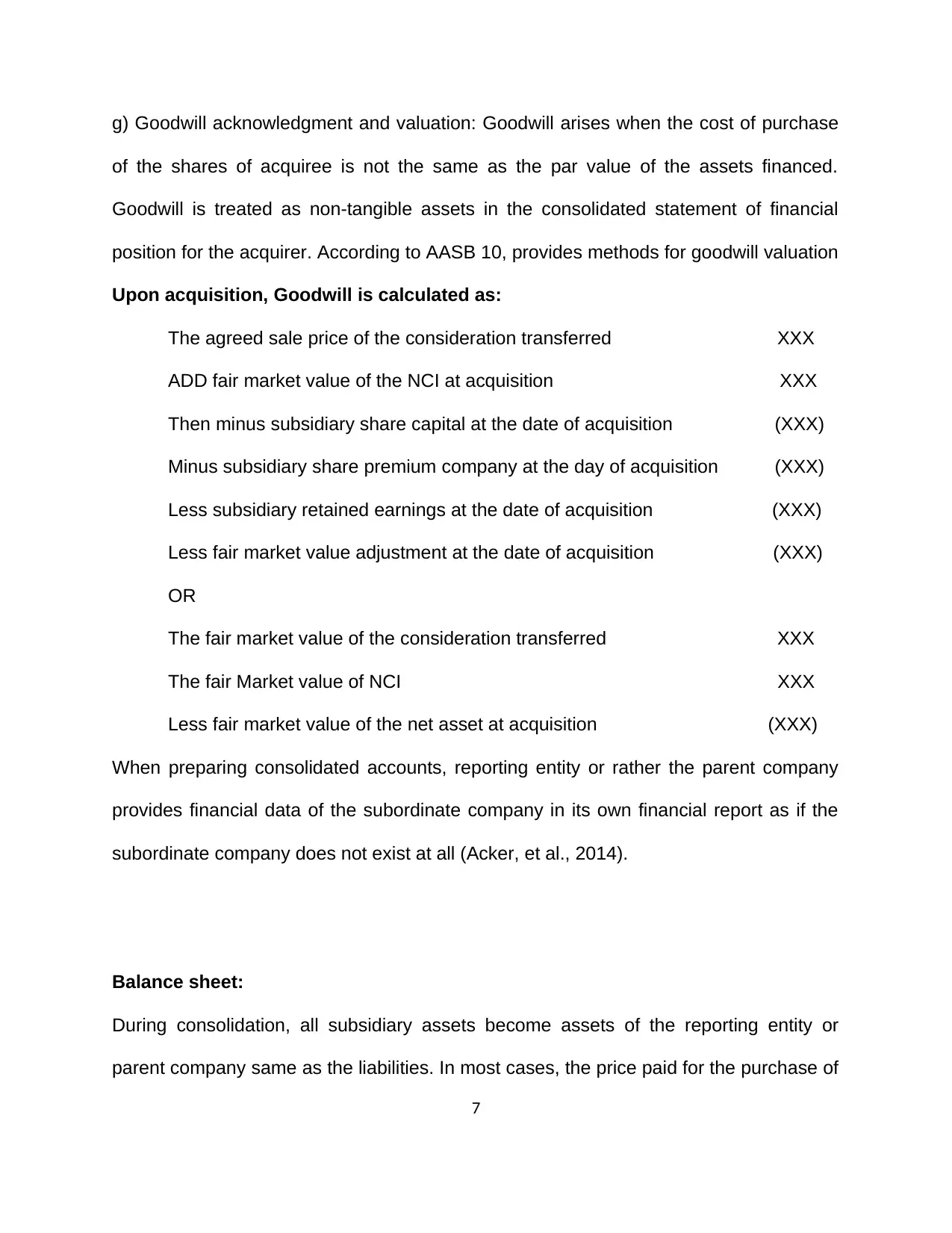
g) Goodwill acknowledgment and valuation: Goodwill arises when the cost of purchase
of the shares of acquiree is not the same as the par value of the assets financed.
Goodwill is treated as non-tangible assets in the consolidated statement of financial
position for the acquirer. According to AASB 10, provides methods for goodwill valuation
Upon acquisition, Goodwill is calculated as:
The agreed sale price of the consideration transferred XXX
ADD fair market value of the NCI at acquisition XXX
Then minus subsidiary share capital at the date of acquisition (XXX)
Minus subsidiary share premium company at the day of acquisition (XXX)
Less subsidiary retained earnings at the date of acquisition (XXX)
Less fair market value adjustment at the date of acquisition (XXX)
OR
The fair market value of the consideration transferred XXX
The fair Market value of NCI XXX
Less fair market value of the net asset at acquisition (XXX)
When preparing consolidated accounts, reporting entity or rather the parent company
provides financial data of the subordinate company in its own financial report as if the
subordinate company does not exist at all (Acker, et al., 2014).
Balance sheet:
During consolidation, all subsidiary assets become assets of the reporting entity or
parent company same as the liabilities. In most cases, the price paid for the purchase of
7
of the shares of acquiree is not the same as the par value of the assets financed.
Goodwill is treated as non-tangible assets in the consolidated statement of financial
position for the acquirer. According to AASB 10, provides methods for goodwill valuation
Upon acquisition, Goodwill is calculated as:
The agreed sale price of the consideration transferred XXX
ADD fair market value of the NCI at acquisition XXX
Then minus subsidiary share capital at the date of acquisition (XXX)
Minus subsidiary share premium company at the day of acquisition (XXX)
Less subsidiary retained earnings at the date of acquisition (XXX)
Less fair market value adjustment at the date of acquisition (XXX)
OR
The fair market value of the consideration transferred XXX
The fair Market value of NCI XXX
Less fair market value of the net asset at acquisition (XXX)
When preparing consolidated accounts, reporting entity or rather the parent company
provides financial data of the subordinate company in its own financial report as if the
subordinate company does not exist at all (Acker, et al., 2014).
Balance sheet:
During consolidation, all subsidiary assets become assets of the reporting entity or
parent company same as the liabilities. In most cases, the price paid for the purchase of
7
Paraphrase This Document
Need a fresh take? Get an instant paraphrase of this document with our AI Paraphraser

a subordinate company is more than its net assets that are, assets minus liabilities, the
extra goes to the balance sheet as a non-tangible asset called goodwill. For instance,
let’s say company A acquires 70% of company B at $500. The total asset of the
company B amounts to $600 and liabilities amounts to $150. The net assets of
company B are equal to $600-$150=$450. Therefore the extra $50 that is $500-$450
goes to the statement of the financial position of the parent company as goodwill.
In consolidating equity, the subsidiary equity disappears and ceases to exist for the
case of financial position and only equity of reporting entity appears. However, if the
parent company doesn't fully own subsidiary, that is it has bought less than 100 %, then
the remaining percentage appears in the equity section as minority interest or non
controlling interest.
Income and cash flow Statements
All subsidiary incomes, expenses, gain, and losses become that of the parent company
with the exception of intragroup balances (Jackson and Chapman, 2012). For instance,
let's say company Y has the salary expense of $40 and company X has the salary
expense of $34, salary expense posted in the consolidated income statement will be
$74 that is $34+$40=$74.
Equity Accounting:
This applied to an entity that has acquired 20% to 50% of the assets of its associate.
The firm does not have control over its associate but has substantial influence
8
extra goes to the balance sheet as a non-tangible asset called goodwill. For instance,
let’s say company A acquires 70% of company B at $500. The total asset of the
company B amounts to $600 and liabilities amounts to $150. The net assets of
company B are equal to $600-$150=$450. Therefore the extra $50 that is $500-$450
goes to the statement of the financial position of the parent company as goodwill.
In consolidating equity, the subsidiary equity disappears and ceases to exist for the
case of financial position and only equity of reporting entity appears. However, if the
parent company doesn't fully own subsidiary, that is it has bought less than 100 %, then
the remaining percentage appears in the equity section as minority interest or non
controlling interest.
Income and cash flow Statements
All subsidiary incomes, expenses, gain, and losses become that of the parent company
with the exception of intragroup balances (Jackson and Chapman, 2012). For instance,
let's say company Y has the salary expense of $40 and company X has the salary
expense of $34, salary expense posted in the consolidated income statement will be
$74 that is $34+$40=$74.
Equity Accounting:
This applied to an entity that has acquired 20% to 50% of the assets of its associate.
The firm does not have control over its associate but has substantial influence
8
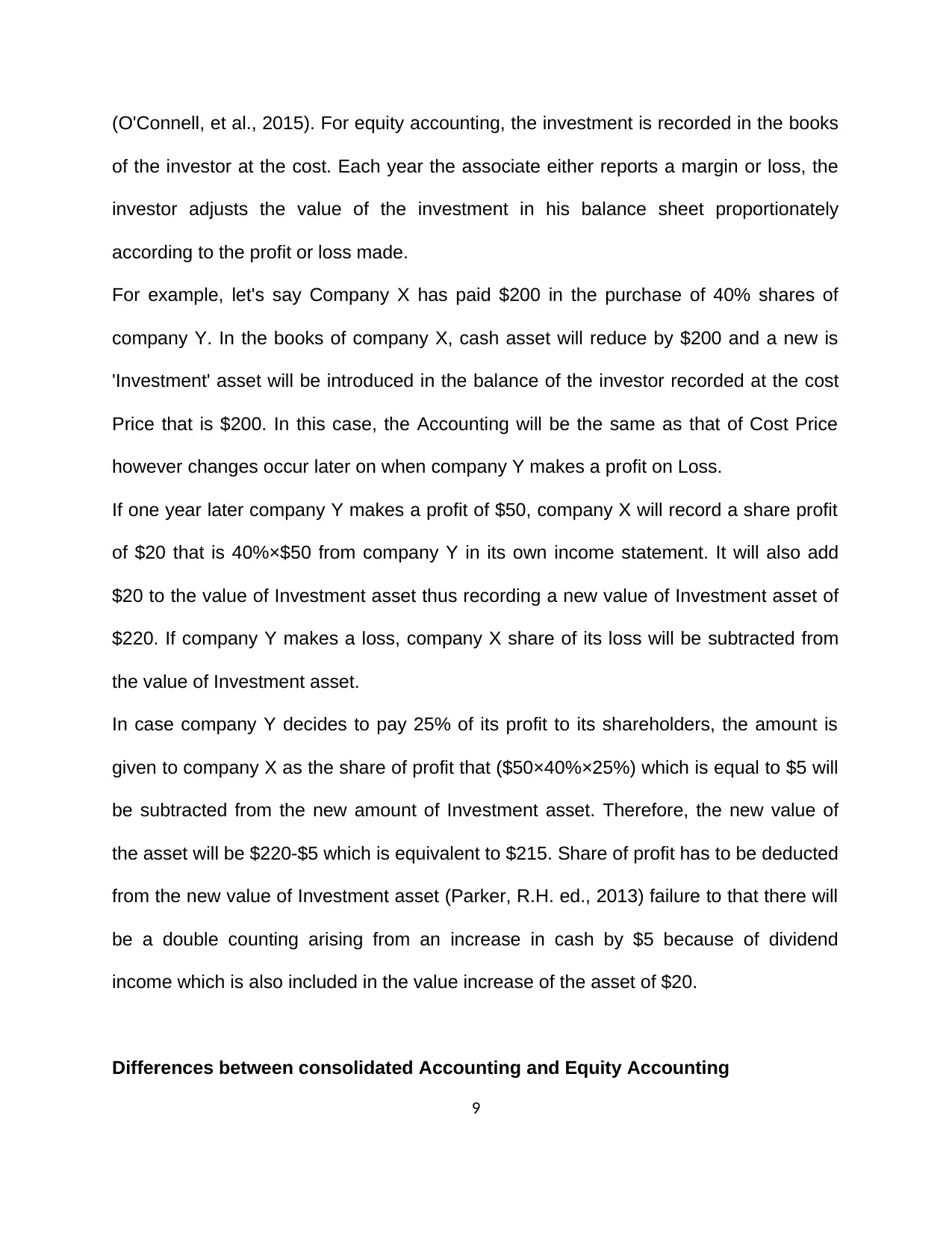
(O'Connell, et al., 2015). For equity accounting, the investment is recorded in the books
of the investor at the cost. Each year the associate either reports a margin or loss, the
investor adjusts the value of the investment in his balance sheet proportionately
according to the profit or loss made.
For example, let's say Company X has paid $200 in the purchase of 40% shares of
company Y. In the books of company X, cash asset will reduce by $200 and a new is
'Investment' asset will be introduced in the balance of the investor recorded at the cost
Price that is $200. In this case, the Accounting will be the same as that of Cost Price
however changes occur later on when company Y makes a profit on Loss.
If one year later company Y makes a profit of $50, company X will record a share profit
of $20 that is 40%×$50 from company Y in its own income statement. It will also add
$20 to the value of Investment asset thus recording a new value of Investment asset of
$220. If company Y makes a loss, company X share of its loss will be subtracted from
the value of Investment asset.
In case company Y decides to pay 25% of its profit to its shareholders, the amount is
given to company X as the share of profit that ($50×40%×25%) which is equal to $5 will
be subtracted from the new amount of Investment asset. Therefore, the new value of
the asset will be $220-$5 which is equivalent to $215. Share of profit has to be deducted
from the new value of Investment asset (Parker, R.H. ed., 2013) failure to that there will
be a double counting arising from an increase in cash by $5 because of dividend
income which is also included in the value increase of the asset of $20.
Differences between consolidated Accounting and Equity Accounting
9
of the investor at the cost. Each year the associate either reports a margin or loss, the
investor adjusts the value of the investment in his balance sheet proportionately
according to the profit or loss made.
For example, let's say Company X has paid $200 in the purchase of 40% shares of
company Y. In the books of company X, cash asset will reduce by $200 and a new is
'Investment' asset will be introduced in the balance of the investor recorded at the cost
Price that is $200. In this case, the Accounting will be the same as that of Cost Price
however changes occur later on when company Y makes a profit on Loss.
If one year later company Y makes a profit of $50, company X will record a share profit
of $20 that is 40%×$50 from company Y in its own income statement. It will also add
$20 to the value of Investment asset thus recording a new value of Investment asset of
$220. If company Y makes a loss, company X share of its loss will be subtracted from
the value of Investment asset.
In case company Y decides to pay 25% of its profit to its shareholders, the amount is
given to company X as the share of profit that ($50×40%×25%) which is equal to $5 will
be subtracted from the new amount of Investment asset. Therefore, the new value of
the asset will be $220-$5 which is equivalent to $215. Share of profit has to be deducted
from the new value of Investment asset (Parker, R.H. ed., 2013) failure to that there will
be a double counting arising from an increase in cash by $5 because of dividend
income which is also included in the value increase of the asset of $20.
Differences between consolidated Accounting and Equity Accounting
9
⊘ This is a preview!⊘
Do you want full access?
Subscribe today to unlock all pages.

Trusted by 1+ million students worldwide

Consolidated Accounting is applied when a reporting entity owns more than 50% of the
subordinate company while Equity Accounting is applied when a company owns
between 20% and 50% of the associate.
In consolidation, the parent company has control over the subsidiary while in equity
Accounting applies to the company has substantial influence over the investee.
In consolidation, all underlying assets and liabilities of the subsidiary become part of the
parent company while in equity accounting; only the value of Investment asset is
recorded in the financial position of investor and adjusted yearly according to the profit
or loss made.
B. Intragroup Transactions:
Intragroup transactions occur when a section an entity engages into transactions with
another unit of the same entity. These circumstances might occur due to a business
relationship that exists between the two units of the entity. These units may be parent
and subsidiary, or subsidiary and another subsidiary, department and another
department or division and another division.
When such scenarios happen to occur, it is important to remember each company
operates differently as a single entity however during consolidation, the adjustments
have to be done in order to reflect a single economic entity.
The common principles applied in intragroup transactions when consolidating accounts
of a group are;
a) Elimination of unrealized profit in the group.
b) Elimination intragroup Receivables and payables.
10
subordinate company while Equity Accounting is applied when a company owns
between 20% and 50% of the associate.
In consolidation, the parent company has control over the subsidiary while in equity
Accounting applies to the company has substantial influence over the investee.
In consolidation, all underlying assets and liabilities of the subsidiary become part of the
parent company while in equity accounting; only the value of Investment asset is
recorded in the financial position of investor and adjusted yearly according to the profit
or loss made.
B. Intragroup Transactions:
Intragroup transactions occur when a section an entity engages into transactions with
another unit of the same entity. These circumstances might occur due to a business
relationship that exists between the two units of the entity. These units may be parent
and subsidiary, or subsidiary and another subsidiary, department and another
department or division and another division.
When such scenarios happen to occur, it is important to remember each company
operates differently as a single entity however during consolidation, the adjustments
have to be done in order to reflect a single economic entity.
The common principles applied in intragroup transactions when consolidating accounts
of a group are;
a) Elimination of unrealized profit in the group.
b) Elimination intragroup Receivables and payables.
10
Paraphrase This Document
Need a fresh take? Get an instant paraphrase of this document with our AI Paraphraser
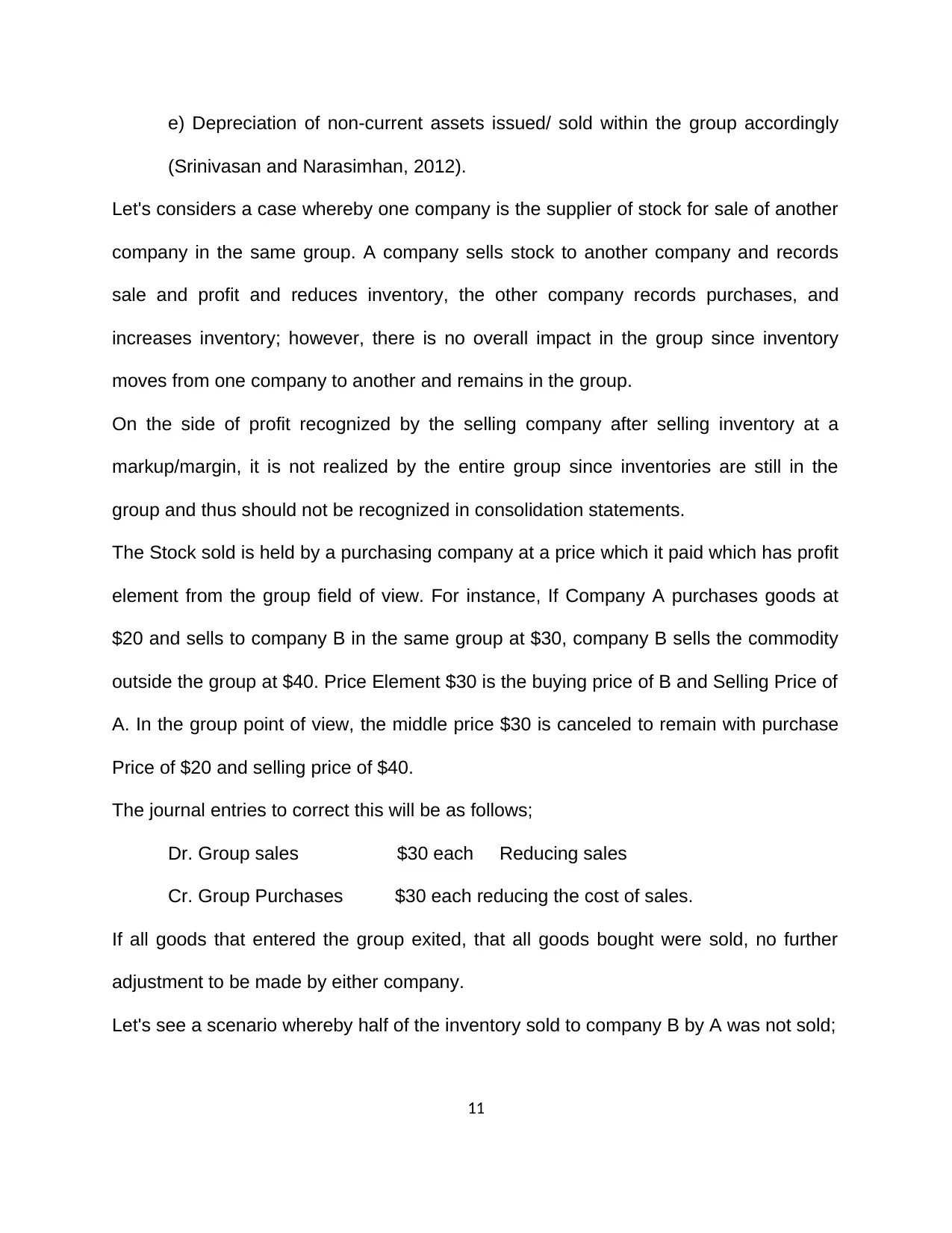
e) Depreciation of non-current assets issued/ sold within the group accordingly
(Srinivasan and Narasimhan, 2012).
Let's considers a case whereby one company is the supplier of stock for sale of another
company in the same group. A company sells stock to another company and records
sale and profit and reduces inventory, the other company records purchases, and
increases inventory; however, there is no overall impact in the group since inventory
moves from one company to another and remains in the group.
On the side of profit recognized by the selling company after selling inventory at a
markup/margin, it is not realized by the entire group since inventories are still in the
group and thus should not be recognized in consolidation statements.
The Stock sold is held by a purchasing company at a price which it paid which has profit
element from the group field of view. For instance, If Company A purchases goods at
$20 and sells to company B in the same group at $30, company B sells the commodity
outside the group at $40. Price Element $30 is the buying price of B and Selling Price of
A. In the group point of view, the middle price $30 is canceled to remain with purchase
Price of $20 and selling price of $40.
The journal entries to correct this will be as follows;
Dr. Group sales $30 each Reducing sales
Cr. Group Purchases $30 each reducing the cost of sales.
If all goods that entered the group exited, that all goods bought were sold, no further
adjustment to be made by either company.
Let's see a scenario whereby half of the inventory sold to company B by A was not sold;
11
(Srinivasan and Narasimhan, 2012).
Let's considers a case whereby one company is the supplier of stock for sale of another
company in the same group. A company sells stock to another company and records
sale and profit and reduces inventory, the other company records purchases, and
increases inventory; however, there is no overall impact in the group since inventory
moves from one company to another and remains in the group.
On the side of profit recognized by the selling company after selling inventory at a
markup/margin, it is not realized by the entire group since inventories are still in the
group and thus should not be recognized in consolidation statements.
The Stock sold is held by a purchasing company at a price which it paid which has profit
element from the group field of view. For instance, If Company A purchases goods at
$20 and sells to company B in the same group at $30, company B sells the commodity
outside the group at $40. Price Element $30 is the buying price of B and Selling Price of
A. In the group point of view, the middle price $30 is canceled to remain with purchase
Price of $20 and selling price of $40.
The journal entries to correct this will be as follows;
Dr. Group sales $30 each Reducing sales
Cr. Group Purchases $30 each reducing the cost of sales.
If all goods that entered the group exited, that all goods bought were sold, no further
adjustment to be made by either company.
Let's see a scenario whereby half of the inventory sold to company B by A was not sold;
11
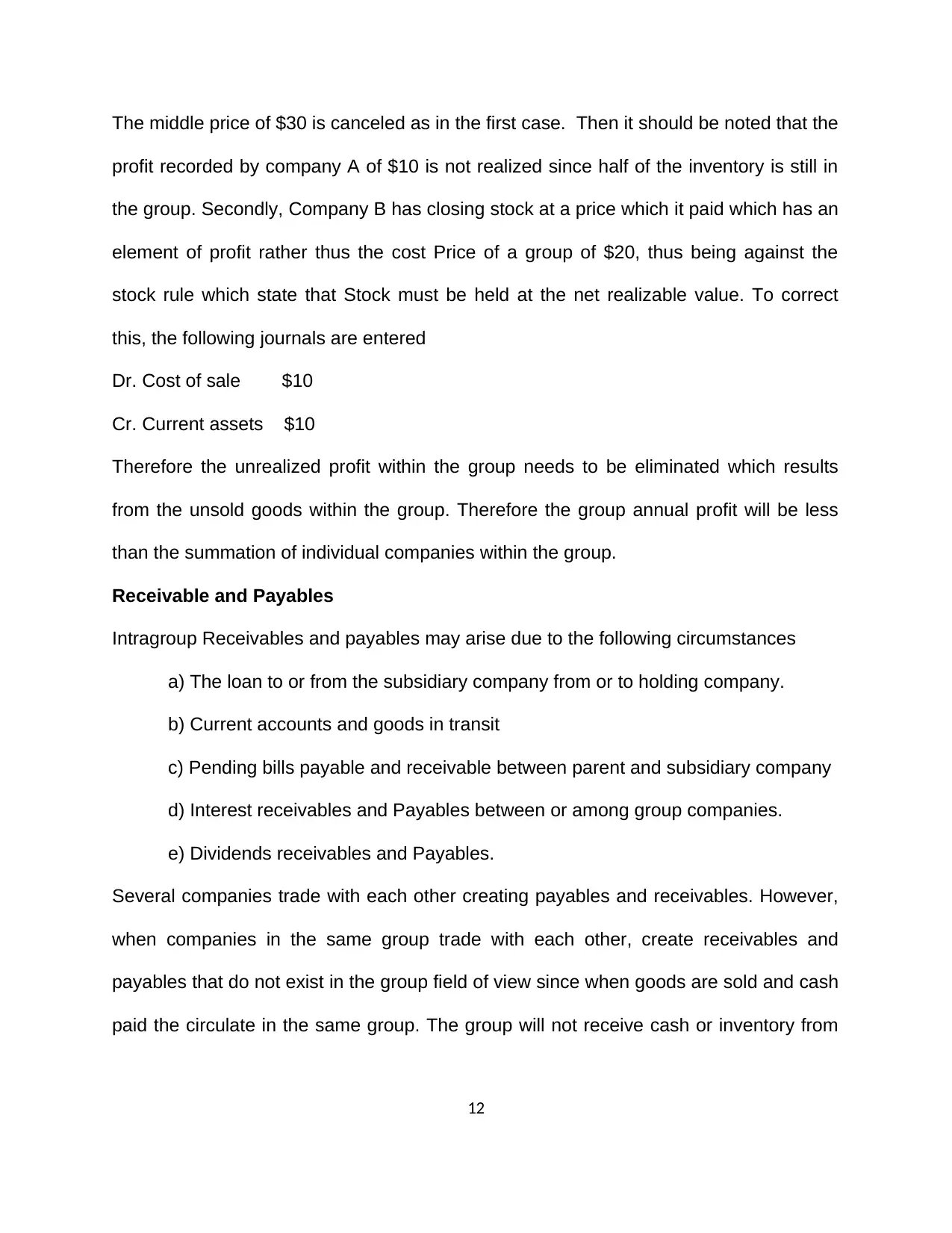
The middle price of $30 is canceled as in the first case. Then it should be noted that the
profit recorded by company A of $10 is not realized since half of the inventory is still in
the group. Secondly, Company B has closing stock at a price which it paid which has an
element of profit rather thus the cost Price of a group of $20, thus being against the
stock rule which state that Stock must be held at the net realizable value. To correct
this, the following journals are entered
Dr. Cost of sale $10
Cr. Current assets $10
Therefore the unrealized profit within the group needs to be eliminated which results
from the unsold goods within the group. Therefore the group annual profit will be less
than the summation of individual companies within the group.
Receivable and Payables
Intragroup Receivables and payables may arise due to the following circumstances
a) The loan to or from the subsidiary company from or to holding company.
b) Current accounts and goods in transit
c) Pending bills payable and receivable between parent and subsidiary company
d) Interest receivables and Payables between or among group companies.
e) Dividends receivables and Payables.
Several companies trade with each other creating payables and receivables. However,
when companies in the same group trade with each other, create receivables and
payables that do not exist in the group field of view since when goods are sold and cash
paid the circulate in the same group. The group will not receive cash or inventory from
12
profit recorded by company A of $10 is not realized since half of the inventory is still in
the group. Secondly, Company B has closing stock at a price which it paid which has an
element of profit rather thus the cost Price of a group of $20, thus being against the
stock rule which state that Stock must be held at the net realizable value. To correct
this, the following journals are entered
Dr. Cost of sale $10
Cr. Current assets $10
Therefore the unrealized profit within the group needs to be eliminated which results
from the unsold goods within the group. Therefore the group annual profit will be less
than the summation of individual companies within the group.
Receivable and Payables
Intragroup Receivables and payables may arise due to the following circumstances
a) The loan to or from the subsidiary company from or to holding company.
b) Current accounts and goods in transit
c) Pending bills payable and receivable between parent and subsidiary company
d) Interest receivables and Payables between or among group companies.
e) Dividends receivables and Payables.
Several companies trade with each other creating payables and receivables. However,
when companies in the same group trade with each other, create receivables and
payables that do not exist in the group field of view since when goods are sold and cash
paid the circulate in the same group. The group will not receive cash or inventory from
12
⊘ This is a preview!⊘
Do you want full access?
Subscribe today to unlock all pages.

Trusted by 1+ million students worldwide
1 out of 18
Related Documents
Your All-in-One AI-Powered Toolkit for Academic Success.
+13062052269
info@desklib.com
Available 24*7 on WhatsApp / Email
![[object Object]](/_next/static/media/star-bottom.7253800d.svg)
Unlock your academic potential
Copyright © 2020–2025 A2Z Services. All Rights Reserved. Developed and managed by ZUCOL.




